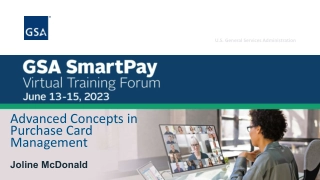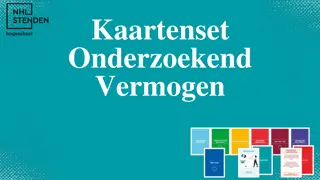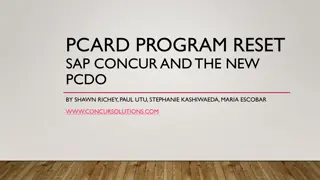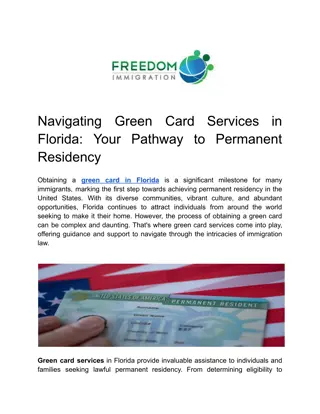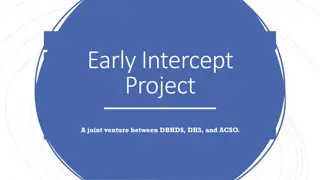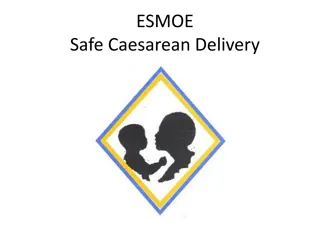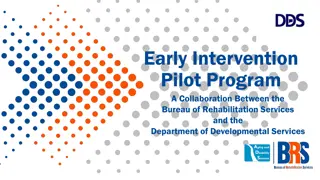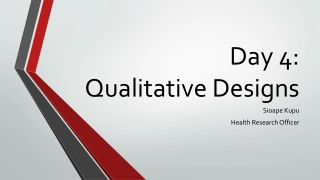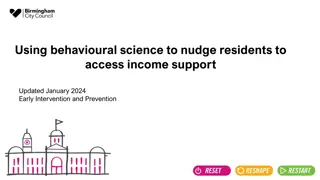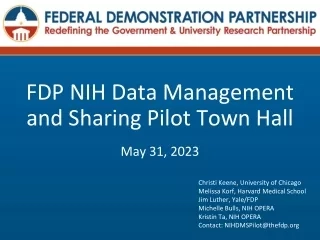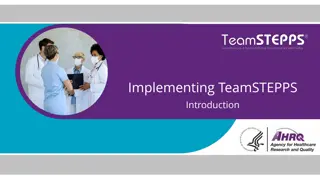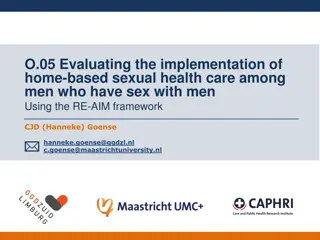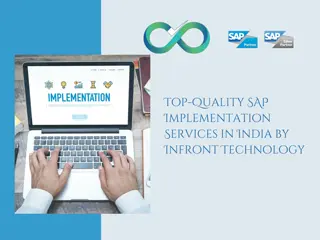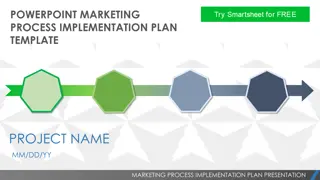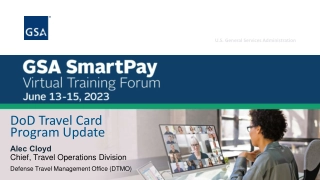Implementation of Discharge Card PHB Pilot for Safe and Early Discharge
Addressing the challenge of patients occupying hospital beds unnecessarily, the report focuses on the implementation of the Discharge Card PHB pilot program aiming to facilitate safe and early discharge in hospitals. Real-world barriers and opportunities for optimal e-wallet use in London are explored through qualitative research methods involving interviews with key stakeholders. The pilot aims to enable timely discharge in a significant number of instances, potentially saving bed days and enhancing value for money.
Implementation of Discharge Card PHB Pilot for Safe and Early Discharge
PowerPoint presentation about 'Implementation of Discharge Card PHB Pilot for Safe and Early Discharge'. This presentation describes the topic on Addressing the challenge of patients occupying hospital beds unnecessarily, the report focuses on the implementation of the Discharge Card PHB pilot program aiming to facilitate safe and early discharge in hospitals. Real-world barriers and opportunities for optimal e-wallet use in London are explored through qualitative research methods involving interviews with key stakeholders. The pilot aims to enable timely discharge in a significant number of instances, potentially saving bed days and enhancing value for money.. Download this presentation absolutely free.
Presentation Transcript
Implementing the Discharge Card PHB pilot to support safe and early discharge Phase 2 This report is not a statement of NHSE Policy Presented by: Behavioural Science Unit, Economics and Strategic Analysis
Context and methods 3
Research objectives QUESTION COMPLICATION SITUATION Most patients are discharged from hospital in a safe and timely way, however some cannot due to a lack of suitable support or accommodation. These fit and healthy patients are unnecessarily using hospital beds which others could use. This is a particularly acute problem during the winter months with considerable impact on patient flows and experience. The London region is unsure about how the five ICBs are using the e- wallet, or if it is being used at all. 1) What are the real-world barriers for optimal e-wallet use in London? 2) What are the real-world opportunities for optimal e-wallet use in London? The region wants to better understand who is using the e-wallet, how the e-wallets are being used and how usage could be increased. London offered five London Integrated Care Boards (ICBs) funding for a discharge Personal Health Budget (e- wallet) to pilot. The e-wallet allows staff to purchase one off items to enable faster and safer discharge for medically optimised patients in pathways 0 and 1. 4
Methods Building on other rapid research undertaken in 2022, we conducted 11 explorative, semi-structured qualitative interviews between April June 2023. We also attended two peer reviews made up of discharge teams from across North West London. Our interviews explored topics such as: Current state of e-wallet implementation in the ICB/trust How staff found out about the e-wallet Who was using the e-wallet Which patients the e-wallet was being used for How staff were using the e-wallet Barriers to implementation What was working well Recommendations for the future Sites Roles ICBs Charing Cross Hospital Chelsea and Westminster Hillingdon Imperial College Healthcare Northwick Park North Middlesex University Hospital Royal Free London University College London Hospital Whittington Health Roles interviewed include: ICB leads Discharge (hub) team leads Inclusion Nurses Project Managers (ICB level) ICB Clinical Lead Personalised Care Lead North West London North Central London South West London North East London South East London 5
Conditions of the pilot Initial analysis of the e-wallet undertaken before this pilot proposed that: Timely and safely discharge could be enabled in up to 28.1% of instances where LoS 7 days This equates to up to 399 bed days per week. Saving anything over 225 bed days (45 per ICB) over the remainder of the financial year (2.6 bed days /week/ ICB) would represent Value for Money. Proposed intervention: Offer includes Success Criteria Qualifying criteria includes ICBs should have their support offer in place from the start of December 2022. No set target for the number of bed days saved. Timely and safely discharge could be enabled in up to 28.1% of instances where LoS 7 days In addition to Pathway 0 or 1, one of three criteria needs to be met: 1. Payment for a good or service would enable early and safe discharge 2. The good or service cannot be provided via existing commissioned services or cannot be provided in a timely manner. 3. The good or service cannot be provided through unpaid care or voluntary sector or cannot be provided by them without this additional support. 18,000 via an MOU with each London system to set up a model and e-wallet infrastructure to enable one-off PHBs to be offered in at least one hospital discharge team in their area by December 2022. (To break even , a saving of at least 45 bed days/ ICB before the end of March would be required (based on each bed day estimated to cost 400, and our support offer being 18,000)) (If any one of the above met, then additional criteria must then be met: see notes.) 6
Without the e-wallet, ICBs use the following Discharge and inclusion teams work within hospitals to support and organise patient discharge. Occasionally patients experience a low-cost issue which stops or delays their discharge. In this instance, patients either wait in hospital until this is resolved, or discharge team staff within the hospital look for alternatives Nothing Personal cash Patients wait for the issue to be resolved, eg wait for social care to provide the item or service. Discharge team staff use their own cash to purchase the solution to the barrier, and then claim the money back from the hospital. Petty cash / credit cards Donations Discharge team staff use local Facebook groups to ask if residents have eg clothing to donate to the patient Discharge team staff have access to petty cash or a credit card they can use (sometimes with limited or preapproved companies) 7
E-wallet PHB status (as of September 2023) North West London and North Central London use MySupport Money or MySupport Broker. South West London uses Care Banking (launched in May 2023). South East London has not procured an e-wallet and instead is using an existing scheme, Safely Home in two Trusts. Staff are able to purchase similar items using a credit card and approved suppliers. There have been procurement challenges for a separate e-wallet. North East London has not yet procured an e- wallet due to organisational restructuring and procurement challenges. 8
Introducing Behavioural Science 9
What is behavioural science? Behavioural Science is the scientific study of human behaviour. Applied Behavioural Science uses the findings and approaches from behavioural science systematically to influence a specific behaviour. We re always trying to change behaviours. What we do and how we do it has an impact on those around us. Whether we want it to or not. Understanding behavioural science and applying it can help us to get to desired behavioural outcomes and avoid undesirable ones. 10
Our approach to changing behaviours Define behaviours to change: Who? What? When? Understand barriers and drivers for those behaviours Apply, test and learn Design potential solutions 11
1 Defining behaviours to change: who, what, and when 12
Identifying Key Behaviour To address the issues in the current state of the e-wallet PHB, our first goal is to identify the main factors associated with using or not using the e-wallet. To do this, we must identify the key behaviours / steps that matter most on the journey to Implementing the e-wallet initially Identifying patients for the e-wallet Using the e-wallet and discharging patients Journey to discharge By mapping out this journey in detail, we can target each of the steps in turn, rather than risk overlooking crucial parts of the problem This informs what behaviours or steps on the journey are most suitable to target with potential recommendations / interventions in the future. 13
E-wallet process (post procurement) Know about it To use the e-wallet, staff need to know that it exists and who can use it. Information is often shared by (discharge) team leads to other staff who are involved in patient discharge at the trust. 1 Remember to use it Once staff are aware, they then need to remember to consider using the e-wallet when considering patients who have a delayed discharge and who might be eligible for the e-wallet 2 Know how to use it Staff must know how the card can be used, for whom and for what, be able to use it and to check that it has solved the barrier to discharge. This includes liaising with other teams; identifying the solution to patient discharge; gaining any necessary approvals and making the purchase 3 4 Feed back about using it Once the e-wallet has been used, staff need confirm it solved the issue, feed back to leads about how it has been used and ideally tell more colleagues about the e-wallet to spread the word 14
2 Understand key barriers and drivers for those behaviours 15
Overall, the e-wallet seems successful Our research has identified five types of barriers that may be getting in the way of maximising its impact. These are: I think we felt that it was going to be good in terms of overcoming some of those barriers that result in kind of increased length of stay in hospital even like you said, just small things like food shops, mattresses, heaters, etcetera. I think the reality has been that. Physiotherapist 1. Not enough people know about the e-wallet pilot Staff can struggle to recall the e-wallet in real time Anxiety about doing it wrong Concerns about who should pay Do not know what money can be spent on 2. Before this wallet idea came up, we had to spend from our own salary. We bought from our own card and then we used to get it refunded by the trust. That's how we were doing. People were a bit reluctant to do that. Senior Nurse 3. 4. 5. 16
Staff were complimentary about the initial success of the e-wallet Patients feel more valued Senior Nurse The money isn t the problem anymore. That s the easy part Physiotherapist It s definitely really good and I don t want it to be taken away Nurse . One [e-wallet] payment can save a week stay. Or like you said in the first example, a whole month It improves the patient s journey Senior Nurse Senior Nurse I think it s fantastic. It s really easy to use Senior Nurse Card is a game changer Hub Lead It s such a good project, it reduces length of stay and we spend less but save more Hub Lead It s not only saving bed days. It s improving their quality of care Senior Nurse 17
Barrier 1: Not enough people know about the e-wallet Although staff were complimentary about the e-wallet, some barriers were identified Discharge teams1 work with many different professionals throughout the hospital, such as physiotherapists, occupational therapists, consultants, individual wards etc Other teams / professionals are not aware of the e-wallet pilot which can lessen the usage of the e-wallet and / or lead to delays in using the e-wallet to discharge patients Other teams / professionals could potentially suggest e-wallet usage at any point from when the patient is admitted to hospital2 Some staff are reluctant to promote the pilot due to uncertainty about future funding Staff are extremely busy and may not have the capacity to promote the e-wallet extensively Staff churn can inhibit information flow How can information about the e-wallet be shared with people who need to know in the hospital? I think a big part of probably increasing the usage is trying to get the message out to the wards and saying, don t let these small things keep people in hospital for extended periods of time. Nurse 1 Discharge teams also includes homeless teams, inclusion teams; any other teams where card holders are based 2 In some areas the e-wallet could be used to prevent admission 18
Barrier 2: Staff can struggle to recall the e-wallet Discharge teams work with many different professionals throughout the hospital. When discussing patient discharges, the e-wallet is not always easily recalled and staff (discharge teams / other staff working with patients in the hospital) can struggle to remember it exists as a potential solution. Conversations about discharge can happen at any point in the patient journey through hospital potentially to even to prevent admissions How can the e- wallet be front of mind for discharge teams when discussing patient discharge? But I think so much of it is almost like habitual that even like myself as a card holder, I do have to remind myself like oh, I could just go and get what we need. Nurse It doesn't always like pop into my head as a solution when we're problem-solving things. If I'm being honest. But we'll work on that. Nurse 19
Barrier 3: Anxiety about doing it wrong Discharge team staff can feel anxious about spending NHS money, especially without additional layers of bureaucracy Some discharge staff feel anxious about getting it wrong and about being responsible for any potential mistakes / issues / consequences How can discharge staff feel empowered and enabled to use the e-wallet? Other discharge staff (feel they) need to get approval for every item purchased Additional information: Any item over 200 (or 250 with postage) requires additional sign off, which is a simple and quick process with the (ICB) lead All card holders need to share information about what they have used the card for with their ICB leads regularly, documenting each usage with a simple form. They re [staff] reluctant to spend money sometimes, or they feel like, like you said, there's always doubts. Senior Nurse 20
Barrier 4: Concerns about who should pay Some (discharge team) staff feel that if patients could pay for items, they should rather than the NHS Others feel that social care should be buying these items Sometimes it is cheaper for the NHS to use the e- wallet to save bed days rather than waiting for the patient / social services to pay In these instances, the e-wallet can be used to purchase items / services for patients How can discharge staff feel comfortable using the e-wallet when accessing other funds would take longer? 21
Barrier 5: Do not know what money can be spent on Discharge team staff and other patient facing staff in hospitals often did not know what the e-wallet could be used for Some were unsure about what other services / options were available within the Trust for patients Others did not know whether certain items were allowed to be purchased Some staff wanted to purchase in bulk and needed additional agreement to purchase mobile phones in bulk Others wanted to pay for handymen services by transferring money / paying with cash and did not know how to do so with the card What is the best way to share with discharge and other hospital staff what the e-wallet has been used on / can be used for? We see it as it needs to be related to discharge. So, I guess I don't know how to quantify that. Anything that kind of will help to overcome the barriers to get somebody out, [ ] I don't know if this is right or not is that it wouldn't be for anything that's outside of that. Senior Nurse 22
3 Develop potential solutions 23
Designing interventions A common framework we use to identify proven behaviour change techniques for NHS challenges such as these is the EAST framework. This framework highlights four simple ways to apply behavioural insights by making it as Easy, Attractive, Social and Timely as possible for people to adopt a desired behaviour. 24
The EAST framework Defaults: we have a strong tendency to go with the default or pre-set option as it is easier Simplify messages: making the message clear often results in a significant increase in response rates to communications Minimum hassle: the effort required to perform an action often puts people off. Reducing the effort can increase uptake Easy Attract attention: we are more likely to do something that our attention is drawn towards, such as by using images, colour or personalisation Personalise the message: such as by using names Provide incentives: financial incentives can be effective, but alternatives such as lotteries also work well and often cost less Attractive Draw attention to social norms: show that most people perform the desired behaviour Use network nudges : those we come into contact with shape our actions. Networks can provide support and encourage behaviours to spread peer to peer. Encourage commitment and reciprocity: we often use commitment devices to voluntary lock ourselves into doing something in advance Social Encourage planning: prompt people to identify the barriers to action and develop a specific plan to address them to decrease the gap between intentions and behaviour Be aware of future discounting: we are more influenced by costs and benefits that happen immediate rather than those that happen later Use timely prompts: prompt people when they are likely to be most receptive Timely 25
How weve used the EAST framework Gathered feedback Summarised key points Used the EAST framework when making recommendations Listened to staff during interviews and focus groups, gathering their opinions, hearing their experiences and collating ideas about potential solutions. These have been recorded and are listed in the appendices The feedback was reviewed, grouped by themes and summarised into key points for each of the barriers to using the e- wallet. Dominant and frequent themes were prioritised Using the EAST framework, we have made recommendations that can help colleagues to use and scale up the e-wallet 26
Framing the recommendations Recommendations are shown according to the stages of using the e-wallet, which are: Know about it To use the e-wallet, staff need to know that it exists and who can use it 1 Remember to use it Once staff are aware, they then need to remember to consider using the e-wallet when considering patients who have a delayed discharge and who might be eligible for the e- wallet 2 Know how to use it Staff must also know how the card can be used, for whom and for what, and to check that it has solved the barrier to discharge 3 Feed back about using it Once the e-wallet has been used, staff need to feed back to leads about how it has been used, on what and ideally tell more colleagues about the e-wallet to spread the word 4 27
Section 1 may be more relevant for newer users of the 1 1 Know about the e-wallet In interviews and workshops, we heard that staff are not always aware that the e-wallet exists or know what it can be used for. We recommend: 2 e-wallet 3 4 Talk about the e-wallet as the default option: embed information about it into core documents, routine meetings and regular and preferred communication channels. It could also be embedded into (eg Emergency Department) handover processes Reassure staff when funding has been secured for longer, so they want to invest the effort and energy to tell colleagues about it Call the e-wallet something fun, memorable and catchy (see appendix) Share information about the e-wallet in attractive ways that will grab staff attention. Use what works locally and preferred communication channels Easy You said make them check off whether they've considered an e-wallet before they use any of the other 'fixes' Attractive Social Appeal to network nudges by sharing attractive and memorable case studies to staff. Reassure staff they too can use the e-wallet by sharing case studies from peers, and emphasise the benefits to the patients, the NHS and themselves by using the e-wallet Use existing opportunities to talk about the e-wallet (such as protected learning time) where champions could arrange sessions to run through the e-wallet Make time to share great examples of how it's helped - more likely to stick in people's minds Timely 28
Section 2 is relevant for all users of the 1 2 Remember to use the e-wallet Staff do not always remember to use the e-wallet in real time . We recommend: e-wallet 2 3 4 Easy Putreminders about the e-wallet where staff normally congregate (such as in break areas, meeting rooms) but also where decisions to use the e- wallet are made and where staff are likely to be most receptive You said put the reminders and info wherever they are going to fix the problem. for example, if there's a petty cash spot - cover it with e- wallet stuff. Attractive Make sure reminders are attractive and grab attention, such as colourful stickers, lanyards, screensavers. Champions could even make little videos describing how staff have used the e-wallet and share them with their team If possible, personalise reminders to staff as much as possible Nominate a champion to spread the word and promote e-wallet use. Be selective when choosing a champion; nominate a proactive, credible person who is enthusiastic about the e-wallet to spread the word. The more talkative and connected the person, the more the message will spread! Help staff to use if/then rules to create a prompt to remember the e-wallet. For example, if I see a homeless patient, I should then consider whether an e-wallet is suitable to use. If I hear a colleague talking about a discharge, then I will ask if the e-wallet has been considered. Social Print out tons of bright neon stickers and put them on anything that discharge staff carry around e.g. iPads or clipboards (if paper forms), ward phones? pagers? Timely 29
Section 3 may be more relevant for newer users of the 1 3 Know how to use it Staff do not always know how to use the e-wallet or what it can be used for. We recommend: 2 e-wallet 3 4 Easy People learn by doing, so let staff practice using the e-wallet to gain confidence. Start with smaller purchases then move to larger purchases to learn that the process itself is easy and straightforward. Be creative in your scenario to encourage creative thinking and problem-solving. Encourage a learning mindset, particularly from leaders. Share mistakes and normalise making errors: if we do not occasionally make mistakes, we aren t being creative enough! Encourage staff to support each other. If support groups do not emerge organically, (or even if they do!) then set them up. For example, fortnightly meetings between card holders and approvers can be useful for creating solutions to challenges and learning from peers. WhatsApp groups can help to share info quickly about potential solutions Create friendly competition between sites / staff to encourage use (it will also spread success stories and give other card users ideas about how they can use the e-wallet). Review regularly and reward creative thinking You said Outline what you can't spend PHB on: no alcohol, tobacco, gambling, primary healthcare, or prescription charges. Otherwise, everything else is possible! Attractive Social In a positive way, share case studies when the use was wrong (e.g. over 200 without ICB approval) and yet the sky didn't fall in. Errors are OK, so long as we learn from them 30
Section 4 may be more relevant for newer users of the 1 4 Feed back about using it Staff do not always know what the e-wallet can be used on and need to feed back where it has been used for monitoring purposes. We recommend: 2 e-wallet 3 4 Easy Share FAQs to bust myths and share workarounds (eg allowed to buy items in bulk such as bedding where it makes sense and saves time; can buy smartphones that are valued less than 200, can transfer money) Create visually appealing case studies that celebrate successes. These may not be the cases with the most bed days saved, but the most creative or innovative use of the e-wallet As before, encourage staff to support each other. If support groups do not emerge organically, (or even if they do!) then set them up. For example North West London had a fortnightly call with those involved with the e- wallet and it was a constructive forum to brainstorm solutions to challenges, get approvals for purchases, feed back learnings and connect with fellow colleagues doing similar work Continue to work with responsive card providers and e-wallet leads to ensure (approvals) processes are as quick and simple as possible You said Share a 'spend of the week' story to make newsworthy. Include in existing comms channel. Attractive Social Leaders highlighting the most imaginative/impactful uses of the e-wallet. Timely 31
4 Apply, test and learn 32
Potential following steps The most effective interventions/solutions are often those that are first pre-tested in a controlled environment. Such tests allow us to apply our solutions test their efficacy learn which solution may be most effective before wider rollout. For example, pre-testing could be used to identify the optimal way to present information about the e-wallet. In an experimental setup, we could divide a sample of staff into subgroups, varying the interventions (e.g. different ways of framing and presenting information about the e-wallet) between those groups. This could then provide a measure of which solutions are most positive for improving understanding of the e-wallet and likelihood to use it. 33
Appendix Feedback from workshops where barriers to using the e-wallet were explored 34
The first barrier to using the e-wallet was that not enough people know about it which links to recommendation 1 In interviews and focus groups, you suggested 1 2 3 Framing the e-wallet as the first port of call or the default option Make language more accurate and desirable when discussing the e- wallet. It is not a budget; it s a grant but not a grant. Name it something catchy / funny / clever Stop describing the e-wallet as 'new or a 'pilot as this leads to staff fearing it may end, sometimes limiting the effort and energy they invest when promoting the e-wallet to colleagues Use champions (or extra staff) to promote the e-wallet & collect case studies. The e-wallet needs a dedicated team member who knows the process inside out and can collect learning and story telling Share the case studies with staff. Tell stories in three bullet points: problem, solution, impact such as bed days saved. If something works and is easy, it ll get used! Get senior leadership buy-in and make the case for change by focusing on patient flow, bed days saved and / or costs saved Embed info about e-wallet into routine meetings & core documentation, but also share information in new and innovative ways (see clipboard) Identify who needs to know about the e-wallet such as departments; teams; individuals and voluntary and share information with them regularly in a drumbeat . Work with comms departments to support the message Train staff about it & share (searchable) info on intranet Share information about e-wallet at start of patient journey through hospital, ie through A&E to pick up need earlier and start process earlier 4 Ways to share info E-wallet language ideas Create staff videos about e-wallet and impact on their work and patient flow The magic card that makes it less hard Share via whatever means possible: poster; word of mouth; screensavers. Talk about it daily Spend your way out! Spend to save Use a QR code for an intranet page on PHBs: - "Does your patient need something bought for them to enable them to go home? and show pictures of shoes, keys, mobile phones etc Get discharge done E-wallet: the solution in your pocket See it, e-wallet it, sorted! Use repeated, simple messages in person and in written form, linked to searchable intranet info on how to access Speedy discharge Expedited discharge Discharge wallet / card 35
The 2nd barrier identified was that not enough people remember to use the e-wallet in real time which links to recommendation 2 In interviews and focus groups, you suggested 1 2 3 Stop describing as 'new' / 'pilot' Create case studies of successes; use show and tell Share cost of inaction by sharing bed day cost - so the e-wallet spend seems more Value For Money Create if/then rule, eg if you see X type of patient, then you should consider the e-wallet Name it something catchy / funny / clever / rhyming maybe with a jingle! Share reminders / info / visual prompts (including both all colleagues in discharge teams and colleagues in wider teams) Train / educate staff & let them practice. If people are more confident that they are using it in the right way, they will probably use it more frequently Expand card usage to wider teams, eg to shift leads Flag delayed discharge patients to champions to flag potential use cases Put information in core documentation (e.g., discharge checklist; change forms / computer systems to include e-wallet considered checkbox before more complex things can be requested ) Put prompts in team spaces, break rooms, offices, wards, discharge hubs etc Share info about e-wallet in ward meetings such as multi disciplinary team meetings. 4 Make time to share great examples of how it's helped - more likely to stick in people's minds put the reminders and info wherever they are going to fix the problem. for example, if there's a petty cash spot - cover it with e-wallet stuff. Print out tons of bright neon stickers and put them on anything that discharge staff carry around e.g. ipads or clipboards (if paper forms), ward phones? pagers? make them check off whether they've considered an e-wallet before they use any of the other 'fixes' 36
The 3rd barrier identified was that staff feel anxious about doing it wrong , which feeds into recommendations 3 & 4 In interviews and focus groups, you suggested 1 2 Simplify the process. eg below a certain threshold the team does not have to do a lot of justification/paperwork. This will empower and will make the process less scary . Streamline paperwork; combining consent and support plan for example. Practice (using card) and provide reassurance: as a transition, introduce some fake approval processes to help reassure staff. maybe remove it after a period when the ward / hospital can show there has been no actual problems Share (short) case studies and examples of how the e-wallet has been used, and the number of different types of purchases made Feed back (when things go right and wrong ) Make forms available if helpful, and have the forms they need to use printed and outside the office of whoever has to sign off to encourage discussion Provide clear communication about the e-wallet and make sure staff can access all relevant documents easily Have a champion in each team and/or nominated person to arrange purchases and handle admin Use a peer checking process Provide support internally and / or from ICB to debrief and share challenges, reflect on how it s being used . Could also embed a peer checking process [an] informal quick chat with a peer before purchasing Emphasise the cost / benefit of using the e-wallet. Be pragmatic especially around who should pay (health/social care an arbitrary divide; priority is earlier discharge / patient flow / bed days saved). Go with the fastest route to facilitate discharge; e-wallet is the fastest/easiest. Use a leaderboard and friendly competition 3 Outline what you can't spend PHB on: no alcohol, tobacco, gambling, primary healthcare, or prescription charges. Otherwise, everything else is possible! 4 Get leaders on board with making mistakes, eg it's allowed, it's going to happen at some point... you wouldn't worry about getting a piece of kit for a patient out of the store room - this should feel the same - not over complicated In a positive way, share case studies when the use was wrong (e.g. over 200 without ICB approval) and yet the sky didn't fall in. Errors are OK, so long as we learn from them Encourage idea of "having a go" and sharing successes and failures as a team' show what happens if a mistake is made emphasising that it's really not that bad. 'we can fix it together' not 'you'll be on a disciplinary' be clear about what misuse of the card would look like.' 37
The 4th barrier was that staff are unsure about what can be bought, which feeds into recommendations 3 & 4 1 2 In interviews and focus groups, you suggested 3 Give explicit rules about how e-wallet can be used and keep it simple Give case studies of what works for whom and in what circumstances, and examples of items that can / have been bought, (although give just a few spend examples; eg don't bother sharing the obvious stuff) . Share the value to the patient of the e-wallet purchase Feed back the benefits to senior leaders Create FAQs Bulk buy items where it makes sense and saves time or money Celebrate successes (daily): today I got Mr X home by Create friendly competition, eg biggest saving made Promote creativity: show top ten purchases for each trust and bottom ten purchases to provoke more creative use Work with colleagues early in the patient journey through hospital to encourage earlier usage of the e-wallet Have regular (multidisciplinary team) meetings and brainstorm what can be bought Put information in core documentation Share existing services / framework of providers & what options are available 4 show some items as 'pre- purchased' (they aren't, but showing that they are might make people more comfortable selecting items and easily understanding what can/can't be bought) Leaders highlighting the most imaginative/impactful uses of the e-wallet. incorporate examples in the checklist. so it's not just 'have you thought about using the e- wallet' but 'would clothing help? Y/N', 'would improving their home help? Y/N' etc Share a 'spend of the week' story to make newsworthy. include in existing comms channel. 38


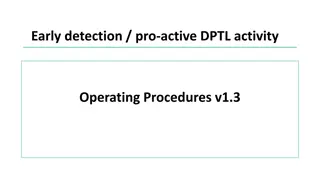



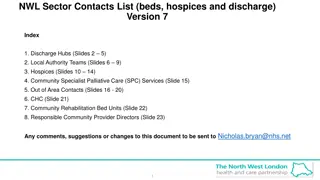
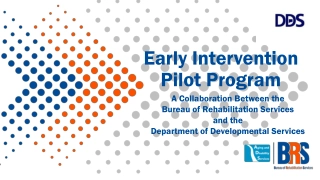



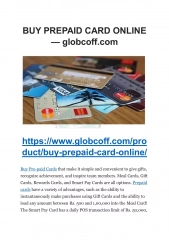
![Guardians of Collection Enhancing Your Trading Card Experience with the Explorer Sleeve Bundle [4-pack]](/thumb/3698/guardians-of-collection-enhancing-your-trading-card-experience-with-the-explorer-sleeve-bundle-4-pack.jpg)
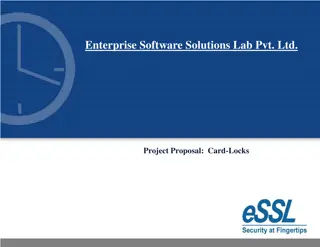
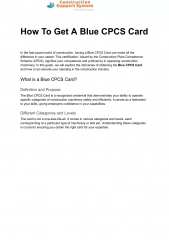

![Read⚡ebook✔[PDF] Linking the Space Shuttle and Space Stations: Early Docking Te](/thumb/21519/read-ebook-pdf-linking-the-space-shuttle-and-space-stations-early-docking-te.jpg)


